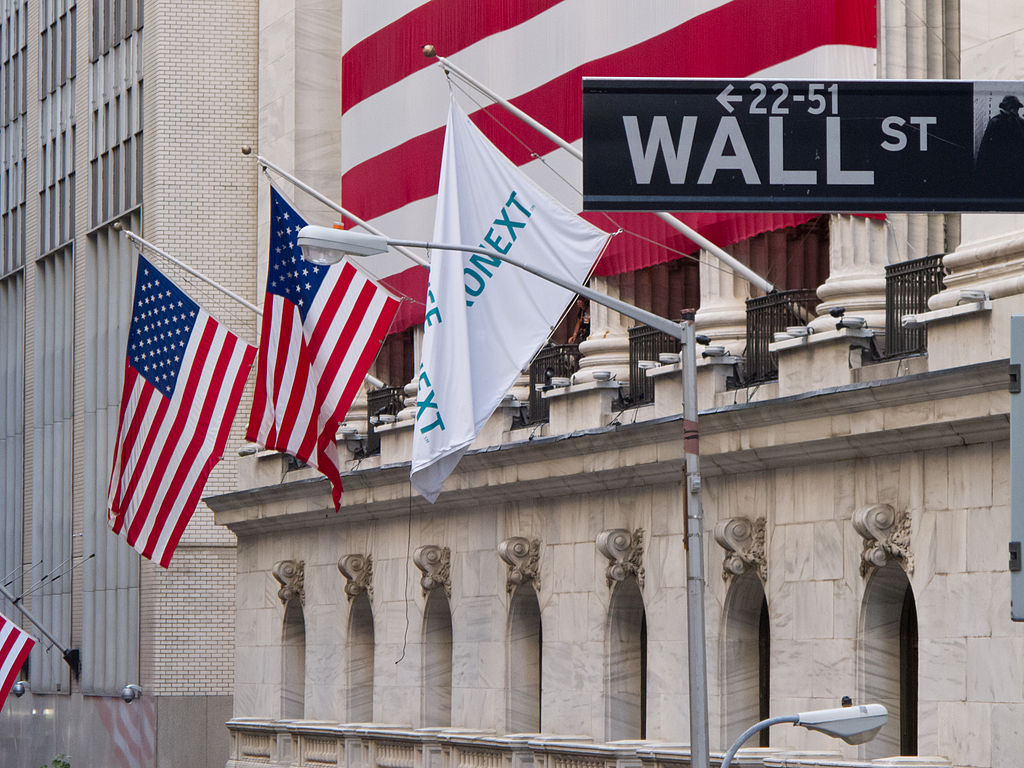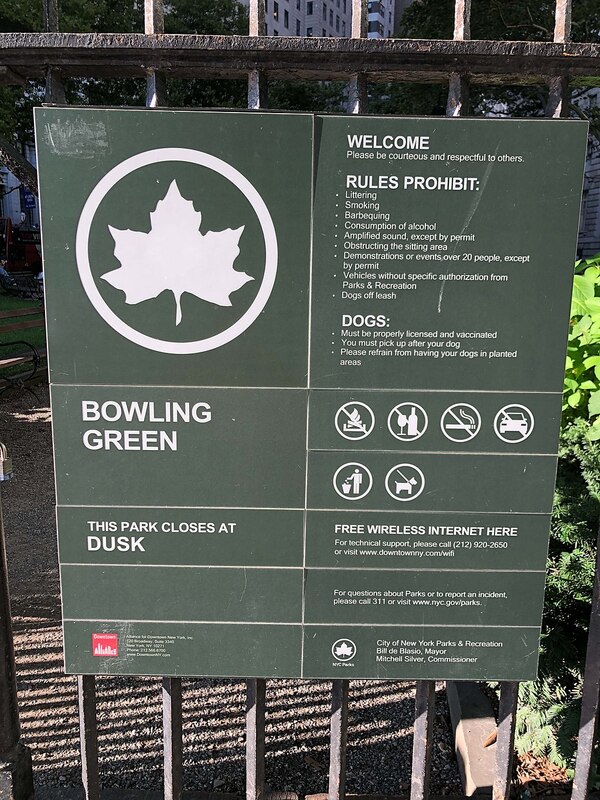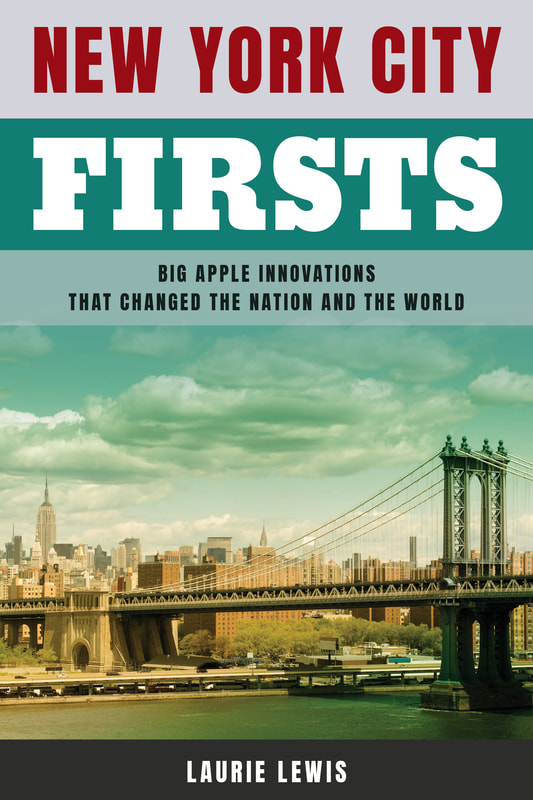Streets in the Financial DistrictBy Laurie Lewis When the Commissioners’ Plan of 1811 laid out the numbered streets and avenues of New York City north of Houston Street, the creative naming of roads came to an end. In Lower Manhattan, however, where early settlers had already named the streets, the appellations reveal much about the history of the city. The first European settlers were the Dutch, who arrived in 1624. In 1653, concerned about a possible British invasion, the Dutch erected a wooden wall running the width of their settlement on the northern border. Over time, the wall gradually disappeared, as first the Dutch and then the English, who took control of New York City in 1664, helped themselves to wood to heat their homes and businesses. Although the last remnants of the wall were removed in 1699, it lives on in the name of perhaps the most famous street in New York. The building seen in the photo above, the New York Stock Exchange, is on the corner of Wall and Broad Streets. The Dutch built a canal here running the length of their settlement to facilitate commercial traffic from the East River. On each side of the canal was a street with homes and businesses. By 1676, the canal had become polluted, and it was filled in. The canal and the paths on either side were covered to create a new street, which was much wider—or broad—than other streets in the area. In the mid-1650s, Stone Street became the first paved street in New York City. A brewery and tavern were on this street, and horse-drawn vehicles bringing goods to and from these establishments stirred up a flurry of dust. The solution: pave the street with cobblestones. Some streets in the Financial District take their names from landowners during the Dutch colonial period. Cortlandt Street runs through the land of Oloff Van Cortlandt, a leading citizen of the colony. John Street was named for John Harpendingh, a wealthy shoemaker. Beaver Street honors an animal that was plentiful in old New York. Beaver pelts were the first major export in colonial times. America’s first multimillionaire, John Jacob Astor, made his initial fortune in the fur trade. The beaver was so important to the city’s early economy that it appears on the official seal of the city. When the Dutch arrived, Lower Manhattan was much narrower than it is today. It expanded over the centuries through landfill. Pearl Street, which originally abutted the East River, got its name because of the many oyster shells found along the banks. Water Street, today the next thoroughfare to the east, once was literally under water. As a result of landfill in the 1800s, former boat slips became streets, including Coenties Slip, Old Slip, and Peck Slip. Names of the area’s parks also reflect colonial history. The oldest park in the city is Bowling Green, created in 1733 in the British colonial period when the land was rented for “one peppercorn a year for the recreation and delight of the inhabitants of this city.” One of the activities in the park was lawn bowling (similar to the Italian bocce); hence the park’s name. Hanover Square (another park) and Hanover Street were named for the British House of Hanover. They are among the few place names honoring British royalty that were not changed after the Revolutionary War. The tree streets in the Financial District were not dubbed because of vegetation growing there but result from the desire to erase the British colonial past. Pine Street was once King Street, and Cedar Street was Little Queen Street. Liberty Street used to be called Crown Street. Streams once coursed through Lower Manhattan. They were eventually filled in to create land for the rapidly developing city. The only reminder of one stream is a narrow, curved street called Maiden Lane, an homage to the young Dutch women who did their laundry in the natural waterway. See Streets in the Financial District on Jane’s Walk Every year during the first weekend in May, New York and other cities across the globe celebrate Jane’s Walk. Named for long-time New Yorker and urban activist Jane Jacobs, the weekend consists of free tours in all five boroughs. This year I’ll be leading a walk called Financial District: It Happened Here First. Based in part on my book New York City Firsts: Big Apple Innovations That Changed the Nation and the World, this Jane’s Walk goes to the sites of the first religious services in the city, the first financial institutions, the first government buildings, and many other New York originals. The tour takes place twice: on Friday, May 5, at 3 PM and on Sunday, May 7, at 1 PM. Can’t attend in person? No problem! A few Jane’s Walks are virtual, including my It Happened Here First: Herald Square to Madison Square. It offers walking directions for those who prefer to see the sights on the street, at their own schedule and pace, rather than on a screen. To register for these walks and to learn where to find them, as well as to see the complete roster of the 165 offerings on this year’s Jane’s Walk, go to https://www.mas.org/janes-walk-nyc-2023. New York City Firsts: Big Apple Innovations That Changed the Nation and the World by Laurie Lewis tells about the creation of more than 300 New York originals. Read about the birth of the safety pin, the Oreo, and the rock musical, among other things. New York City Firsts was selected as a finalist in the 19th annual Best Book Awards sponsored by American Book Fest. It was a nominee for the 9th annual Apple Awards given by the Guides Association of New York City (GANYC). Find out more about the book, including links to buy it, at www.nycfirsts.com. We are no longer scheduling public tours that are open to anyone, but we are available for private tours. If you would like ideas for private tours, please see the Tours page on this website. Comments are closed.
|
Archives
April 2024
|






